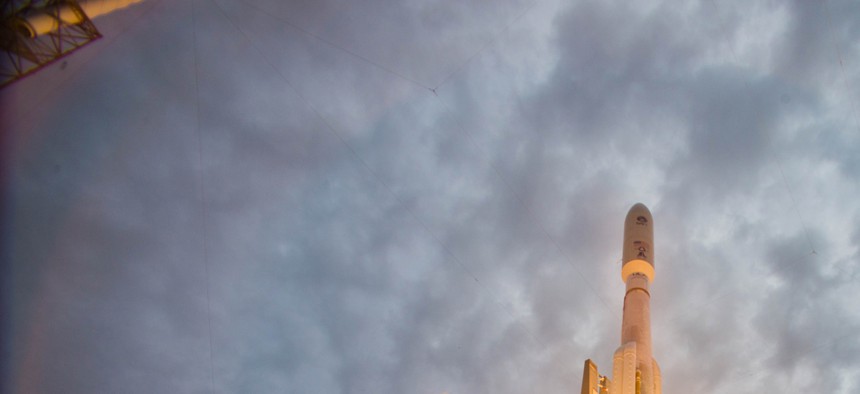
An Atlas V rocket launches the Navy's Mobile User Objective System 2 satellite Patrick H. Corkery/AP
Why the Military Needs Commercial Satellite Technology
The need for commerical satellite technology will only grow as data usage increases and more UAVs take to the air due to the asymmetrical threat environment. By Rick Lober
Imagine you are in a Global Hawk. Like the U-2 aircraft, it flies high, positioned over target areas to survey contested territory on the ground, taking in thousands of square miles a day. At this altitude, you’d have to wear a pressure suit to survive, just like the venerable pilots of the U-2, whose aerial photography helped avert a potential nuclear war during the Cuban Missile Crisis. These aircraft are just as critical, but unlike the U-2, you can’t fly in a Global Hawk; it’s an unmanned aerial vehicle. Whereas the U-2 carried actual rolls of film, which then needed to be processed and scrutinized, the Global Hawk beams both its flight and surveillance data down in real time via satellite. There’s only one looming showstopper: the Department of Defense is running out of satellite bandwidth.
Global Hawks originally were planned to be operated using the Defense Department’s high-capacity Transformational Satellite Communication System, or TSAT, with support for protected tactical, strategic and ISR communication. The TSAT program was cancelled in 2009 and currently the Wideband Global SATCOM (WGS) program, a constellation of 10 satellites with six currently in orbit, is the Pentagon’s MILSATCOM system. But just one Global Hawk requires a data rate of hundreds of megabits per second, or Mbps, or about 10 to 20 percent of the aperture capacity of each satellite. Today, there are over 40 Global Hawks, meaning that these UAVs alone could take up 80 percent of the constellation’s total capacity. Realizing this discrepancy, the DOD quickly revisited its satellite bandwidth plan. So, is there a fleet of UAVs sitting in a hangar somewhere held back from flying? No, because Global Hawks and the military’s fleet of UAVs do not need to depend on military satellites. Instead, they use commercial SATCOM or, for short range missions, direct downlinks to ground terminals.
The idea of the military using commercial satellite technologies makes some people uneasy. There are questions about security, control and coverage, and of course about costs. But one thing that isn’t being questioned: commercial SATCOM works. And there’s a lot of it. For example, one military WGS satellite has only four gigabits of capacity, compared with recent commercial satellites offering more than 100 gigabits. To put it in context, just one such commercial satellite has more capacity than the WGS constellation combined. Greater capacity may be one reason why the Pentagon spends nearly $1 billion each year on commercial bandwidth.
Measuring satellite usage, however, isn’t apples-to-apples. While a commercial provider could potentially serve millions of users, the Defense Department will only serve up to 20,000 for each WGS satellite. Hence, not only does a commercial satellite have more capacity, it is about four times more efficient at using its capacity on a gigabit per user basis.
And what about those security concerns? New waveforms and advanced modems with certified, enhanced military security protocols can be incorporated into existing terminals to deter attack or interference.
Despite these realities, there are still people within the Defense Department that question the viability of commercial SATCOM. Many UAVs were designed to use commercial satellite because it made sense operationally, and forcing DOD to embrace it at a policy level. Recently, Frank Kendall, undersecretary of defense for acquisition, technology and logistics, started down this path. In May 2013, he had the Pentagon begin devising a plan to increase satellite bandwidth for UAVs. It’s a positive first step, but department planners should also find ways to extend commercial innovations for its own military systems. For example, WGS capacity can be tripled or quadrupled if bandwidth is managed more efficiently. All the Pentagon would need to do is invest in improved modems and network management tools. Australia and Canada are already leading the way in higher capacity usage over WGS.
Commercial SATCOM is critical to the military’s future. Already, it meets 80 percent of DOD’s SATCOM needs. This will only grow, as data usage increases and more UAVs take to the air due to the asymmetrical threat environment. In the next decade, it is estimated the department will increase its spending on new UAVs by 30 percent to an unprecedented $40 billion. These aircraft will need more bandwidth, and when they do, commercial SATCOM will be there to meet the need.
Rick Lober is general manager and vice president of the defense and intelligence systems division at Hughes.
NEXT STORY: Blackberry Bets Big on the Defense Department



